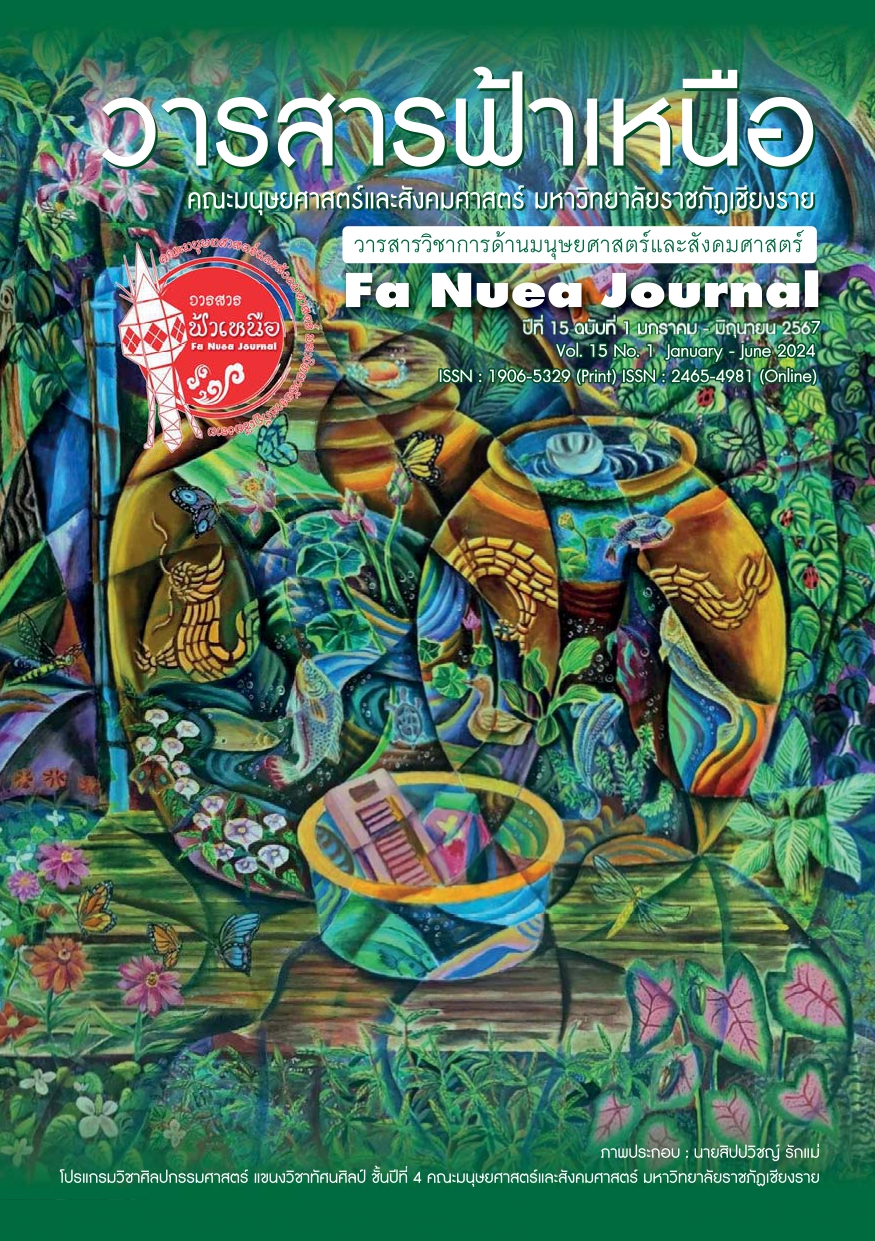Using Folk Literature as a Tool for Communicating Community Product Identity: A Case Study of Kongkan Village, Mae Suek Subdistrict, Mae Chaem District, Chiang Mai Province
Main Article Content
Abstract
This research aims to utilize folk literature as a tool for communicating the community product identity. The study employs both quantitative and qualitative research methods, utilizing quantitative and qualitative research tools to assess and develop the community's perception of their cultural heritage as it relates to tourism management. This includes examining literature related to local customs and resources, conducting structured and unstructured interviews with subgroups, and developing a community product identity communication program using folk literature as a tool. The research and development yielded the following results: 1) Folk literature has the potential to effectively communicate the community product identity, particularly folk narratives related to local customs and resources. Approximately 80% of the population in Kangkan Village, totaling 325 individuals, approved and supported the use of folk literature, particularly older narratives related to community customs and resources, as a means of identity communication for community products. They expressed support for the development of folk literature to enhance the uniqueness of community products. 2) The development of community products with a unique identity using folk literature as a tool received substantial support, with approximately 80% of the Kangkan Village population, totaling 325 individuals, favoring and supporting such products. Moreover, five market experts unanimously agreed that community products with a unique identity developed using folk literature as a tool could be successfully marketed and 3)The development of a communication tool for community products with a unique identity using folk literature as a tool achieved an efficiency score (E1/E2) of 70 points, as specified. This indicates the tool's success in using folk literature to communicate community product identity effectively and sets the stage for future communication efforts. Furthermore, the analysis compared to the criteria and achieved a score of 2.8%, indicating the tool's success in future communication.
Article Details

This work is licensed under a Creative Commons Attribution-NonCommercial-NoDerivatives 4.0 International License.
Articles, information, content, pictures, etc. which have been published in Fa Nuea Journal, are copyright of Fa Nuea Journal. If any person or party wishes to disseminate all or part of it or take any action must be referenced. Do not use for commercial purposes and do not modify (CC-BY-NC-ND). For further details, please access at Attribution-NonCommercial-NoDerivatives 4.0 International (CC BY-NC-ND 4.0)
References
กรมวิชาการ กระทรวงศึกษาธิการ. (2545). คู่มือการพัฒนาสื่อการเรียนรู้. โรงพิมพ์คุรุสภาลาดพร้าว.
ฉัตรทิพย์ นาถสุภา. (2548). แนวคิดเศรษฐกิจชุมชน ข้อเสนอทางทฤษฎีในบริบทต่างสังคม (พิมพ์ครั้งที่ 2). อัมรินทร์พริ้นติ้ง แอนดพ์ บลิชชิ่ง.
ดารินท์ คำพันธ์ และสุจิตรา เปลี่ยนรุ่ง. (2565). การสื่อสารอัตลักษณ์สินค้ากระเป๋าโอทอปของกลุ่มผู้ผลิตและผู้ประกอบการ. วารสารมนุษยศาสตร์และสังคมศาสตร์ มหาวิทยาลัยราชภัฏบ้านสมเด็จเจ้าพระยา, 16(1), 45-68.
บุญเกื้อ ควรหาเวช. (2532). นวัตกรรมการศึกษา. เจริญวิทย์การพิมพ์.
ปฐม หงส์สุวรรณ. (2550). กาลครั้งหนึ่ง: ว่าด้วยตำนานกับวัฒนธรรม. สำนักพิมพ์แห่งจุฬาลงกรณ์มหาวิทยาลัย.
ปาริชาติ ยาน้อย. (2562). อัตลักษณ์ตราสินค้าและการสื่อสารการตลาดโดยการมีส่วนร่วมของชุมชนเพื่อส่งเสริมการท่องเที่ยวกาดข่วงเมืองน่าน (ถนนคนเดินวัดภูมินทร์). [วิทยานิพนธ์มหาบัณฑิต ไม่ได้ตีพิมพ์]. สถาบันบัณฑิตพัฒนบริหารศาสตร์.
พิศาพิมพ์ จันทร์พรหม และคณะ. (2564). นวัตกรรมการผลิตเฉดสีและผ้าทอตามอัตลักษณ์ของชุมชนเพื่อพัฒนาพัฒนาผู้ประกอบการชุมชนเพื่อสังคม อำเภอแม่แจ่ม จังหวัดเชียงใหม่. กองทุนส่งเสริม ววน. และหน่วย บพท.
ยศ สันตสมบัติ. (2540). มนุษย์กับวัฒนธรรม. สำนักพิมพ์มหาวิทยาลัยธรรมศาสตร์.
ศิราพร ณ ถลาง. (2552). ทฤษฎีคติชนวิทยา วิธีวิทยาในการวิเคราะห์ตำนาน-นิทานพื้นบ้าน (พิมพ์ครั้งที่ 2). สำนักพิมพ์จุฬาลงกรณ์มหาวิทยาลัย.
สมสุข หินวิมาน และคณะ. (2560). การใช้ประโยชน์จากงานวิจัยด้วยเครื่องมือการสื่อสาร : การพัฒนากลุ่มคน. สำนักงานกองทุนสนับสนุนการวิจัย (สกว.).
สายันต์ ไพรชาญจิตร์. (2549). การจัดการทรัพยากรทางโบราณคดีในงานพัฒนาชุมชน. โครงการหนังสือโบราณคดีชุมชน.
Bascom, William. (1965). Four Functions of Folklore. In Alan Dundes (Ed.), The Study of Folklore (pp. 279-298). Prentice-Hall.
Kotler, Philip. (1997). Marketing management :Analysis, planning, implementation and control (5th ed.). Prentice Hall.
Storytelling กลยุทธ์ทาง Content Marketing ที่สำคัญต่อผู้บริโภค. (2564, 25 มีนาคม). Storytelling กลยุทธ์ทาง Content Marketing ที่สำคัญต่อผู้บริโภค. Marketingoops. https://www.marketingoops.com/exclusive/how-to/storytelling-content-marketing/


